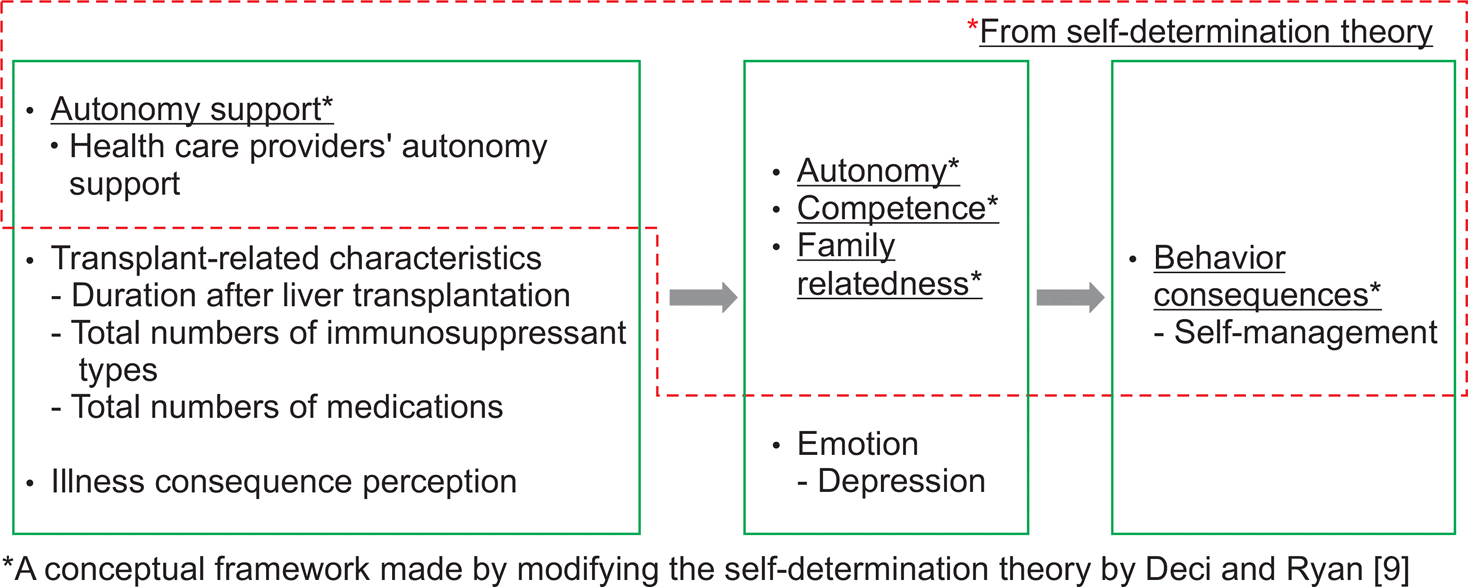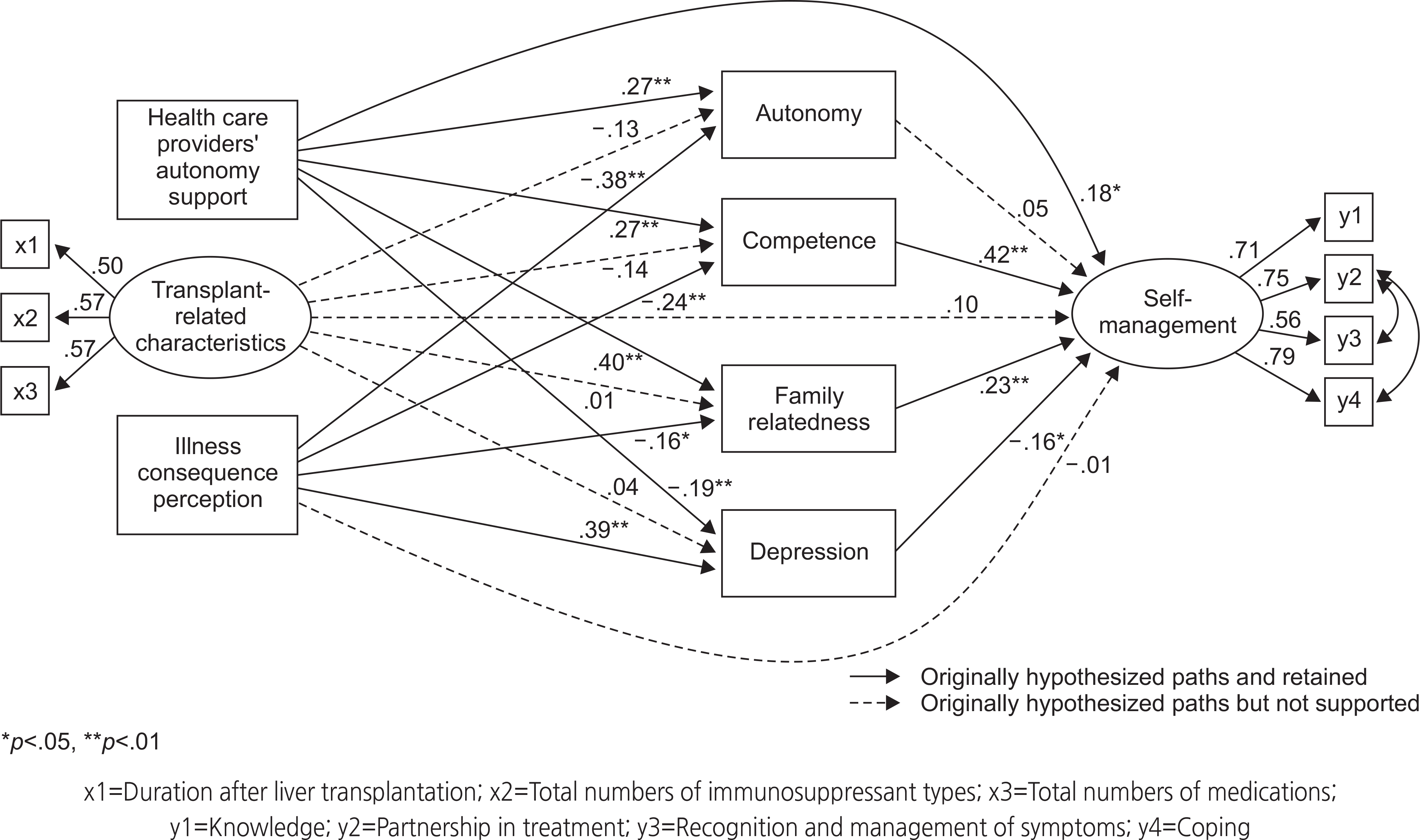Abstract
Purpose
The purpose of this study was to construct and test a structural equation model of self-management of liver transplant recipients based on self-determination theory.
Methods
Participants were 275 outpatients who received liver transplantation. A structured self-report questionnaire was used to assess health care providers’ autonomy support, transplant-related characteristics, illness consequence perception, autonomy, competence, family relatedness, depression and self-management. Collected data were analyzed using SPSS/WIN 24.0 and AMOS 24.0 program.
Results
The modified model showed a good fitness with the data: GFI=.96, RMSEA=.06, CFI=.96, NFI=.93, TLI=.93, PGFI=.43, PNFI=.49. The health care providers’ autonomy support, competence, family relatedness and depression were factors with a direct influence on the self-management of liver transplant recipients. The health care providers’ autonomy support and illness consequence perception had an indirect influence through competence, family relatedness and depression. However, the transplant-related characteristics and autonomy did not have a significant effect on self-management. This model explained 59.4% of the variance in self-management.
Conclusion
The result suggests that continuous education must be done to promote the competence of liver transplant recipients and to encourage the patient to positively perceive their current health condition with a view that enhances one's self-management. Additionally, the liver transplant recipients should be screened for depression, which would affect self-management. Most of all, health care providers, who have the most influence on self-management, should improve therapeutic communication and try to form a therapeutic relationship with the liver transplant recipients.
References
1. Lee SG. Living-donor liver transplantation in adults. British Medical Bulletin. 2010; 94(1):33–48. https://doi.org/10.1093/bmb/ldq003.

2. Kasiske BL, Skeans MA, Leighton TR, Ghimire V, Leppke SN, Israni AK. OPTN/SRTR 2011 Annual data report: International data. American Journal of Transplantation. 2013; 13(Suppl 1):199–225. https://doi.org/10.1111/ajt.12026.

3. Korea Network for Organ Sharing (KONOS): Statistical yearbook [Internet]. Seoul: KONOS;c2017. [cited 2017 Jun 8]. Available from. https://www.konos.go.kr/konosis/index.jsp.
4. Rubín A, Sánchez-Montes C, Aguilera V, Juan FS, Ferrer I, Moya A, et al. Long-term outcome of ‘long-term liver transplant survivors’. Transplant International. 2013; 26(7):740–750. https://doi.org/10.1111/tri.12118.

5. Song GW, Ahn CS, Lee SG, Hwang S, Kim KH, Moon DB, et al. Correlation between risk of hepatitis B virus recurrence and tissue expression of covalently closed circular DNA in living donor liver transplant recipients treated with high-dose hepatitis B immunoglobulin. Transplantation Proceedings. 2014; 46(10):3548–3553. https://doi.org/10.1016/j.transproceed.2014.06.074.

6. Ha HS, Jeong JS, Chae YR, Hong JJ, Kim IO, Yi M, et al. Psychosocial adjustment of the organ transplantation recipients in Korea. The Journal of the Korean Society for Transplantation. 2007; 21(2):269–281.
7. McGuire BM, Rosenthal P, Brown CC, Busch AM, Calcatera SM, Claria RS, et al. Long-term management of the liver transplant patient: Recommendations for the primary care doctor. American Journal of Transplantation. 2009; 9(9):1988–2003. https://doi.org/10.1111/j.1600-6143.2009.02733.x.

8. Schulman-Green D, Jaser S, Martin F, Alonzo A, Grey M, McCorkle R, et al. Processes of self-management in chronic illness. Journal of Nursing Scholarship. 2012; 44(2):136–144. https://doi.org/10.1111/j.1547-5069.2012.01444.x.

9. Deci EL, Ryan RM. The “What” and” Why” of goal pursuits: Human needs and the self-determination of behavior. Psychological Inquiry. 2000; 11(4):227–268. https://doi.org/10.1207/s15327965pli1104_01.

10. Williams GC, Lynch M, Glasgow RE. Computer-assisted intervention improves patient-centered diabetes care by increasing autonomy support. Health Psychology. 2007; 26(6):728–734. https://doi.org/10.1037/0278-6133.26.6.728.

11. Smith D, Harvey P, Lawn S, Harris M, Battersby M. Measuring chronic condition self-management in an Australian community: Factor structure of the revised Partners in Health (PIH) scale. Quality of Life Research. 2017; 26(1):149–159. https://doi.org/10.1007/s11136-016-1368-5.

12. Schmidt K, Gensichen J, Petersen JJ, Szecsenyi J, Walther M, Williams G, et al. Autonomy support in primary care: Validation of the German version of the Health Care Climate Questionnaire. Journal of Clinical Epidemiology. 2012; 65(2):206–211. https://doi.org/10.1016/j.jclinepi.2011.06.003.
13. Seo YM, Choi WH. A predictive model on self care behavior for patients with type 2 diabetes: Based on self-determination theory. Journal of Korean Academy Nursing. 2011; 41(4):491–499. https://doi.org/10.4040/jkan.2011.41.4.491.

14. Sim MK, Jeon KO, Kim SI. The effects of symptom distress, social support, and work change on liver transplant recipients. The Journal of the Korean Society for Transplantation. 2013; 27(2):49–56. https://doi.org/10.4285/jkstn.2013.27.2.49.

15. Kim EM, Kim KS. A structural model on quality of life for recipients of liver transplants. Journal of Korean Academy of Fundamentals of Nursing. 2007; 14(3):340–350.
16. Kim KS, Kang JY, Jeong IS. Health related quality of life among organ transplant recipients. Journal of Korean Academy Nursing. 2003; 33(3):365–375. https://doi.org/10.4040/jkan.2003.33.3.365.

17. Yoo HJ, Kim KS. Relationship between stress and the quality of life among the recipients of the living donor liver transplantation. Journal of Korean Clinical Nursing Research. 2013; 19(3):395–406. https://doi.org/10.22650/JKCNR.2013.19.3.395.
18. Akazawa C, Nishizono T, Yamamoto M, Teraguchi S, Hayashi Y. Investigation of actual daily lifestyle leading to continuous self-management after living-donor liver transplantation: More than 5 years living with living-donor liver transplantation and emotions of recipients. Japan Journal of Nursing Science. 2013; 10(1):79–88. https://doi.org/10.1111/j.1742-7924.2012.00214.x.
19. Drent G, De Geest S, Dobbels F, Kleibeuker JH, Haagsma EB. Symptom experience, nonadherence and quality of life in adult liver transplant recipients. The Netherlands Journal of Medicine. 2009; 67(5):161–168.
20. Kung M, Koschwanez HE, Painter L, Honeyman V, Broadbent E. Immunosuppressant nonadherence in heart, liver, and lung transplant patients: Associations with medication beliefs and illness perceptions. Transplantation. 2012; 93(9):958–963. https://doi.org/10.1097/TP.0b013e31824b822d.
21. O’Carroll RE, McGregor LM, Swanson V, Masterton G, Hayes PC. Adherence to medication after liver transplantation in Scotland: A pilot study. Liver Transplantation. 2006; 12(12):1862–1868. https://doi.org/10.1002/lt.20828.
22. Fine RN, Becker Y, De Geest S, Eisen H, Ettenger R, Evans R, et al. Nonadherence consensus conference summary report. American Journal of Transplantation. 2009; 9(1):35–41. https://doi.org/10.1111/j.1600-6143.2008.02495.x.

23. Deci EL, Ryan RM. Self-determination theory in health care and its relations to motivational interviewing: A few comments. International Journal of Behavioral Nutrition and Physical Activity. 2012; 9:24. https://doi.org/10.1186/1479-5868-9-24.

24. Ng JY, Ntoumanis N, Thøgersen-Ntoumani C, Deci EL, Ryan RM, Duda JL, et al. Self-determination theory applied to health contexts: A meta-analysis. Perspectives on Psychological Science. 2012; 7(4):325–340. https://doi.org/10.1177/1745691612447309.
25. Hair JF, Black B, Babin B, Anderson RE, Tatham RL. Multivariate data analysis. 6th ed. Upper saddle River (NJ): Pearson Education International Inc.;2005. p. 740–746.
26. Bae BR. Structural equation modeling with Amos 24. Seoul: Chenngram Books;2017. p. 76–309.
27. Yu JP. The concept and understanding of structural equation modeling. Seoul: Hannare Publishing Co.;2012. p. 150–372.
28. Williams GC, Grow VM, Freedman ZR, Ryan RM, Deci EL. Motivational predictors of weight loss and weight-loss maintenance. Journal of Personality and Social Psychology. 1996; 70(1):115–126. https://doi.org/10.1037/0022-3514.70.1.115.

29. Seo YM. A structural model development for health behavior adherence in hypertensive or diabetic patients [dissertation]. Daegu: Kyungpook National University;2008. p. 1–88.
30. Chen SL, Tsai JC, Lee WL. Psychometric validation of the Chinese version of the illness perception questionnaire-revised for patients with hypertension. Journal of Advanced Nursing. 2008; 64(5):524–534. https://doi.org/10.1111/j.1365-2648.2008.04808.x.

31. Moss-Morris R, Weinman J, Petrie K, Horne R, Cameron L, Buick D. The revised illness perception questionnaire (IPQ-R). Psychology and Health. 2002; 17(1):1–16. https://doi.org/10.1080/08870440290001494.

32. Cha J. Structural equation modeling of quality of life focused on the self-management process in patients with hemodialysis [dissertation]. Seoul: Seoul National University;2014. p. 1–98.
33. Lee MH, Kim AY. Development and construct validation of the basic psychological needs scale for Korean adolescents: Based on the Self-determination theory. Korean Journal of Social and Personality Psychology. 2008; 22(4):157–174.
34. Eo EJ, Yoo YJ. A study on development of the scale for measuring family strengths. Journal of Korean Home Management Association. 1995; 13(1):145–156.
35. Zigmond AS, Snaith RP. The hospital anxiety and depression scale. Acta Psychiatrica Scandinavica. 1983; 67(6):361–370. https://doi.org/10.1111/j.1600-0447.1983.tb09716.x.

36. Oh SM, Min KJ, Park DB. A study on the standardization of the hospital anxiety and depression scale for Koreans: A comparison of normal, depressed and anxious groups. Journal of Korean Neuropsychiatric Association. 1999; 38(2):289–296.
37. Bjelland I, Dahl AA, Haug TT, Neckelmann D. The validity of the Hospital Anxiety and Depression Scale. An updated literature review. Journal of Psychosomatic Research. 2002; 52(2):69–77. https://doi.org/10.1016/S0022-3999(01)00296-3.
38. Petkov J, Harvey P, Battersby M. The internal consistency and construct validity of the partners in health scale: Validation of a patient rated chronic condition self-management measure. Quality of Life Research. 2010; 19(7):1079–1085. https://doi.org/10.1007/s11136-010-9661-1.

39. Ryan RM, Patrick H, Deci EL, Williams GC. Facilitating health behaviour change and its maintenance: Interventions based on self-determination theory. European Health Psychologist. 2008; 10(1):2–5.
40. Park AR. A structural model of health behavior compliance in patients with percutaneous coronary intervention based on self-determination theory [dissertation]. Gwangju: Chonnam National University;2015. p. 1–113.
41. Halvari AEM, Halvari H. Motivational predictors of change in oral health: An experimental test of self-determination theory. Motivation and Emotion. 2006; 30(4):294. https://doi.org/10.1007/s11031-006-9035-8.

42. La Guardia JG, Ryan RM, Couchman CE, Deci EL. Within-person variation in security of attachment: A self-determination theory perspective on attachment, need fulfillment, and well-being. Journal of Personality and Social Psychology. 2000; 79(3):367–384. https://doi.org/10.1037/0022-3514.79.3.367.

43. Kim EM, Suh MJ. Adjustment experience of liver transplant recipient. The Korean Journal of Rehabilitation Nursing. 2003; 6(1):61–69.
44. Hong JJ, Lim KC, Ha HS, Kim IO, Lee SH, Jeon MK, et al. Psychosocial adjustment of pancreas transplant recipients in Korea. Journal of Korean Association for Qualitative Research. 2016; 1:20–31.

45. van Houtum L, Rijken M, Heijmans M, Groenewegen P. Self-management support needs of patients with chronic illness: Do needs for support differ according to the course of illness? Patient Education and Counseling. 2013; 93(3):626–632. https://doi.org/10.1016/j.pec.2013.08.021.

46. Kim H, Choi M, Kim SS, Kim SI. Self-care, social support, and biological markers in liver transplant recipients. Korean Journal of Adult Nursing. 2015; 27(2):170–179. https://doi.org/10.7475/kjan.2015.27.2.170.

47. Corruble E, Barry C, Varescon I, Falissard B, Castaing D, Samuel D. Depressive symptoms predict long-term mortality after liver transplantation. Journal of Psychosomatic Research. 2011; 71(1):32–37. https://doi.org/10.1016/j.jpsychores.2010.12.008.

48. Choi J, Noh GY, Park DJ. Smoking cessation apps for smart-phones: Content analysis with the self-determination theory. Journal of Medical Internet Research. 2014; 16(2):e44. https://doi.org/10.2196/jmir.3061.

49. Lee EH, Park JW. A structural equation model on health behavior adherence for elders with prehypertension: Based on self-determination theory. Journal of Korean Academy of Fundamentals of Nursing. 2012; 19(3):343–352. https://doi.org/10.7739/jkafn.2012.19.3.343.

50. Markus HR, Kitayama S. Models of agency: Sociocultural diversity in the construction of action. Murphy-Berman V, Berman JJ, editors. Cross-Cultural Differences in Perspectives on the Self. Nebraska: University of Nebraska Press;2003. p. 1–58.
Table 1.
Demographic and Transplant-related Characteristics of the Participants (N=275)
Table 2.
Descriptive Statistics and Convergent Validity of Measured Variables (N=275)
Table 3.
Effects of Predictive Variables in the Modified Model




 PDF
PDF ePub
ePub Citation
Citation Print
Print




 XML Download
XML Download